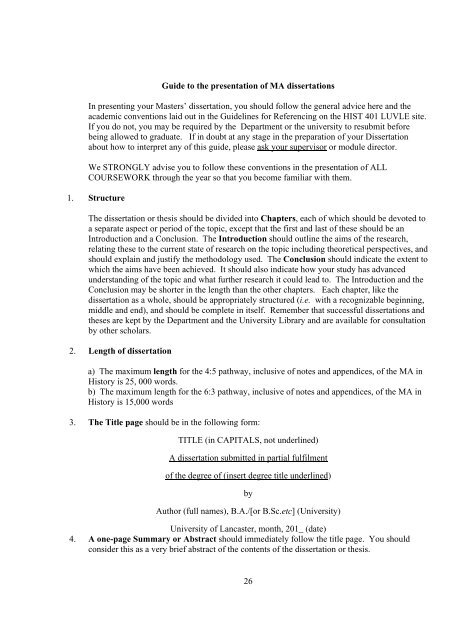M.A. in History Student Handbook 2011-2012
M.A. in History Student Handbook 2011-2012
M.A. in History Student Handbook 2011-2012
Create successful ePaper yourself
Turn your PDF publications into a flip-book with our unique Google optimized e-Paper software.
Guide to the presentation of MA dissertations<br />
In present<strong>in</strong>g your Masters’ dissertation, you should follow the general advice here and the<br />
academic conventions laid out <strong>in</strong> the Guidel<strong>in</strong>es for Referenc<strong>in</strong>g on the HIST 401 LUVLE site.<br />
If you do not, you may be required by the Department or the university to resubmit before<br />
be<strong>in</strong>g allowed to graduate. If <strong>in</strong> doubt at any stage <strong>in</strong> the preparation of your Dissertation<br />
about how to <strong>in</strong>terpret any of this guide, please ask your supervisor or module director.<br />
We STRONGLY advise you to follow these conventions <strong>in</strong> the presentation of ALL<br />
COURSEWORK through the year so that you become familiar with them.<br />
1. Structure<br />
The dissertation or thesis should be divided <strong>in</strong>to Chapters, each of which should be devoted to<br />
a separate aspect or period of the topic, except that the first and last of these should be an<br />
Introduction and a Conclusion. The Introduction should outl<strong>in</strong>e the aims of the research,<br />
relat<strong>in</strong>g these to the current state of research on the topic <strong>in</strong>clud<strong>in</strong>g theoretical perspectives, and<br />
should expla<strong>in</strong> and justify the methodology used. The Conclusion should <strong>in</strong>dicate the extent to<br />
which the aims have been achieved. It should also <strong>in</strong>dicate how your study has advanced<br />
understand<strong>in</strong>g of the topic and what further research it could lead to. The Introduction and the<br />
Conclusion may be shorter <strong>in</strong> the length than the other chapters. Each chapter, like the<br />
dissertation as a whole, should be appropriately structured (i.e. with a recognizable beg<strong>in</strong>n<strong>in</strong>g,<br />
middle and end), and should be complete <strong>in</strong> itself. Remember that successful dissertations and<br />
theses are kept by the Department and the University Library and are available for consultation<br />
by other scholars.<br />
2. Length of dissertation<br />
a) The maximum length for the 4:5 pathway, <strong>in</strong>clusive of notes and appendices, of the MA <strong>in</strong><br />
<strong>History</strong> is 25, 000 words.<br />
b) The maximum length for the 6:3 pathway, <strong>in</strong>clusive of notes and appendices, of the MA <strong>in</strong><br />
<strong>History</strong> is 15,000 words<br />
3. The Title page should be <strong>in</strong> the follow<strong>in</strong>g form:<br />
TITLE (<strong>in</strong> CAPITALS, not underl<strong>in</strong>ed)<br />
A dissertation submitted <strong>in</strong> partial fulfilment<br />
of the degree of (<strong>in</strong>sert degree title underl<strong>in</strong>ed)<br />
by<br />
Author (full names), B.A./[or B.Sc.etc] (University)<br />
University of Lancaster, month, 201_ (date)<br />
4. A one-page Summary or Abstract should immediately follow the title page. You should<br />
consider this as a very brief abstract of the contents of the dissertation or thesis.<br />
26
















